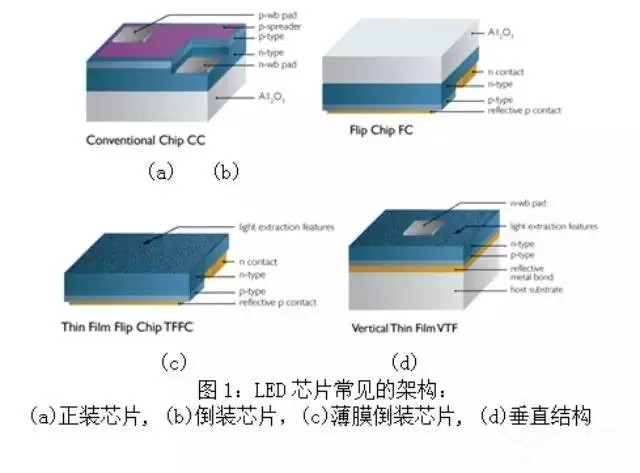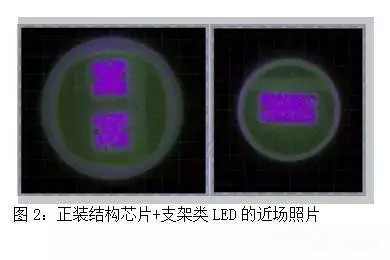
Such chips are widely used in low- and medium-power package products, and the advantages are low price; the disadvantage is that the sapphire has poor thermal conductivity, so the heat dissipation of the chip is poor, and the conductivity of the P-type material is also poor, so the injection current is limited. In addition, the chip is illuminated on five sides, and it is usually required to place the chip in the holder. As shown in FIG. 2, the opening area of ​​the reflector is much larger than the area of ​​the chip, resulting in low luminous flux per unit area, and the color uniformity of the chip surface is very poor. The chip is blue above the front and yellow on the outer ring. This is the reason why yellow circles appear in use, such as spotlights, flat lights, etc.

In order to overcome the shortcomings of poor heat dissipation and limited injection current of traditional dressing structures, some researchers have proposed a flip-chip structure. Heat can be transferred directly from the chip to a substrate such as ceramic without passing through a sapphire substrate with poor thermal conductivity, so the injection current can be significantly increased; the luminous flux per unit area can also be significantly improved. The disadvantage is that the chip is illuminated on five sides, which brings a lot of inconvenience to the occasions that require precise secondary optical design, such as small-angle spotlights, mobile phone flash, car lights, ultra-thin backlights and flat lights. In addition, there are also formal dresses. The problem of uneven color color faced by the five-sided light-emitting chip.
Film flip structure
In order to solve the problem of the flip-chip structure, a film flip-chip structure has been proposed. On the basis of flip chip, the sapphire substrate is removed by laser stripping technology to obtain a single-sided light-emitting film chip. The thin film chip has high light extraction efficiency and concentrated light directly on the chip, which is advantageous for secondary optical design, and also has very good surface color uniformity. However, the complicated laser stripping technology is used, the cost is high, the yield is low, and the chip itself is prone to defects. In addition, due to the flip-chip structure, there is a gap between the chip and the (ceramic) substrate, which is somewhat reduced. The thermal conductivity of the chip; at the same time, due to the very thin chip, it is prone to chip cracks, leakage and other problems in use.
Vertical structure
Corresponding to the film flip-chip structure, there is also a vertical structure chip, similar to the flip chip, the sapphire substrate is stripped, and the high-reverse material is plated on the bottom of the chip, and then the conductive and thermally conductive substrate material is added, so that the chip In addition to the advantages of the single-sided light-emitting chip, it also has good thermal conductivity and electrical conductivity, and the reliability is also very high. The vertical structure is currently the most widely used thin film chip structure, but since the sapphire substrate needs laser stripping, the yield is low and the cost is high, which limits the wider application of the vertical structure chip.
The Silicon Substrate LED Technology Project Group claims that silicon substrate LEDs have the following advantages over traditional sapphire substrates :
(1) Not only when the substrate is grown, the cost of the substrate is much lower than that of the sapphire material, but also the chemical etching method can be used to peel off the substrate, which is much higher in efficiency and yield than the sapphire substrate which must be laser stripped. Get high quality, low cost vertical structure chips.
(2) In combination with the white light chip process, on the one hand, the light-emitting area is reduced, and on the other hand, higher performance is achieved, including the luminous flux per unit area and the color uniformity of the surface of the chip.
(3) The vertical structure of the chip can not only adopt the ceramic packaging process, but also adopt a cheaper bracket packaging method to further reduce the cost of the customer, as shown in Fig. 3, which provides unlimited possibilities for high-quality lighting. With silicon substrate LED chips, LED lighting solutions with better lighting quality, lower system cost, more flexible design and more innovation can be realized.

Talc (Talc) is a layered silicate which is a hydrate.
Theory of MgO style chemical formula 3, 4 - SiO2, H2O, and the theory of chemical composition as follows: 31.68% MgO style SiO2 H2O 63.47% to 4.75%, the natural quality of pure talc ore are very few, most associated with other mineral impurities, common associated minerals include chlorite, serpentine, magnesite, tremolite, dolomite, etc.
Talc is often white, light green, microstrip pink, light grey, with impurities the more the color is deeper, even dark grey, black.
Monoclinic crystal system, ore presents flaky, fibrous and dense.
Pearly luster or oily luster, the heating effect of the talc are substantially heated, lose adsorbed water during 120 ~ 200 ℃, 600 ℃ when begin to lose part of the structure of water, until 1050 when the structure all the water out.
The best way to identify talc is to conduct X-ray diffraction analysis or thermal analysis.
Talc
Micronized Talcum Powder,Mesh Talc Powder,Talc Powder,Talc Powder Paint
Shijiazhuang Xinlongwei Chemical Co., Ltd. , https://www.xinlongwei-chem.com